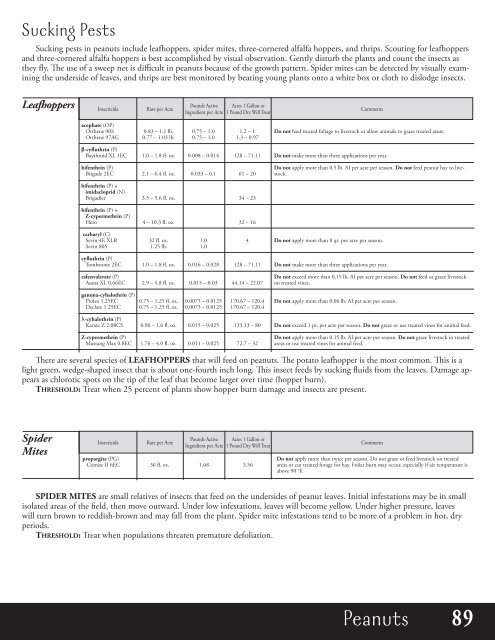Agronomic Crops
mJyPrJ
mJyPrJ
You also want an ePaper? Increase the reach of your titles
YUMPU automatically turns print PDFs into web optimized ePapers that Google loves.
Sucking Pests<br />
Sucking pests in peanuts include leafhoppers, spider mites, three-cornered alfalfa hoppers, and thrips. Scouting for leafhoppers<br />
and three-cornered alfalfa hoppers is best accomplished by visual observation. Gently disturb the plants and count the insects as<br />
they fly. e use of a sweep net is difficult in peanuts because of the growth pattern. Spider mites can be detected by visually examining<br />
the underside of leaves, and thrips are best monitored by beating young plants onto a white box or cloth to dislodge insects.<br />
Leafhoppers<br />
Insecticide<br />
Rate per Acre<br />
Pounds Active Acres 1 Gallon or<br />
Ingredient per Acre 1 Pound Dry Will Treat<br />
Comments<br />
acephate (OP)<br />
Orthene 90S 0.83 – 1.1 lb. 0.75 – 1.0 1.2 – 1<br />
Orthene 97AG 0.77 – 1.03 lb. 0.75 – 1.0 1.3 – 0.97<br />
b-cyfluthrin (P)<br />
Baythroid XL 1EC 1.0 – 1.8 fl. oz. 0.008 – 0.014 128 – 71.11<br />
bifenthrin (P)<br />
Brigade 2EC 2.1 – 6.4 fl. oz. 0.033 – 0.1 61 – 20<br />
Do not feed treated foliage to livestock or allow animals to graze treated areas.<br />
Do not make more than three applications per year.<br />
Do not apply more than 0.5 lb. AI per acre per season. Do not feed peanut hay to livestock.<br />
bifenthrin (P) +<br />
imidacloprid (N)<br />
Brigadier 3.5 – 5.6 fl. oz. 34 – 23<br />
bifenthrin (P) +<br />
Z-cypermethrin (P)<br />
Hero 4 – 10.3 fl. oz. 32 – 16<br />
carbaryl (C)<br />
Sevin 4F, XLR 32 fl. oz. 1.0 4<br />
Sevin 80S 1.25 lb. 1.0<br />
cyfluthrin (P)<br />
Tombstone 2EC 1.0 – 1.8 fl. oz. 0.016 – 0.028 128 – 71.11<br />
esfenvalerate (P)<br />
Asana XL 0.66EC 2.9 – 5.8 fl. oz. 0.015 – 0.03 44.14 – 22.07<br />
gamma-cyhalothrin (P)<br />
Prolex 1.25EC 0.75 – 1.25 fl. oz. 0.0075 – 0.0125 170.67 – 120.4<br />
Declare 1.25EC 0.75 – 1.25 fl. oz. 0.0075 – 0.0125 170.67 – 120.4<br />
λ-cyhalothrin (P)<br />
Karate Z 2.08CS 0.96 – 1.6 fl. oz. 0.015 – 0.025 133.33 – 80<br />
Z-cypermethrin (P)<br />
Mustang Max 0.8EC 1.76 – 4.0 fl. oz. 0.011 – 0.025 72.7 – 32<br />
Do not apply more than 8 qt. per acre per season.<br />
Do not make more than three applications per year.<br />
Do not exceed more than 0.15 lb. AI per acre per season. Do not feed or graze livestock<br />
on treated vines.<br />
Do not apply more than 0.06 lb. AI per acre per season.<br />
Do not exceed 1 pt. per acre per season. Do not graze or use treated vines for animal feed.<br />
Do not apply more than 0.15 lb. AI per acre per season. Do not graze livestock in treated<br />
areas or use treated vines for animal feed.<br />
ere are several species of LeAFHoPPeRs that will feed on peanuts. e potato leafhopper is the most common. is is a<br />
light green, wedge-shaped insect that is about one-fourth inch long. is insect feeds by sucking fluids from the leaves. Damage appears<br />
as chlorotic spots on the tip of the leaf that become larger over time (hopper burn).<br />
tHResHoLD: Treat when 25 percent of plants show hopper burn damage and insects are present.<br />
Spider<br />
Mites<br />
Insecticide<br />
Rate per Acre<br />
Pounds Active Acres 1 Gallon or<br />
Ingredient per Acre 1 Pound Dry Will Treat<br />
propargite (PG)<br />
Comite II 6EC 36 fl. oz. 1.68 3.56<br />
Comments<br />
Do not apply more than twice per season. Do not graze or feed livestock on treated<br />
areas or cut treated forage for hay. Foliar burn may occur, especially if air temperature is<br />
above 90 °F.<br />
sPIDeR MItes are small relatives of insects that feed on the undersides of peanut leaves. Initial infestations may be in small<br />
isolated areas of the field, then move outward. Under low infestations, leaves will become yellow. Under higher pressure, leaves<br />
will turn brown to reddish-brown and may fall from the plant. Spider mite infestations tend to be more of a problem in hot, dry<br />
periods.<br />
tHResHoLD: Treat when populations threaten premature defoliation.<br />
Crop Peanuts Name 89


